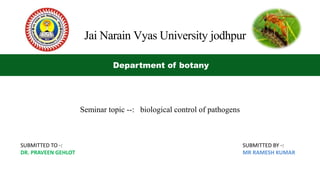
biological control of plantpathogens.pptx
- 1. Seminar topic --: biological control of pathogens Jai Narain Vyas University jodhpur Department of botany SUBMITTED TO -: DR. PRAVEEN GEHLOT SUBMITTED BY -: MR RAMESH KUMAR
- 2. Topics 1. Introduction 2. History of Biological control 3. Biological control 4. Importance of biological control 5. Mode of actions of biocontrol 6. Biocontrol application methods 7. Limitations of biological control 8. Reference BIOLOGICAL CONTROL OF PLANT PATHOGENS
- 3. Introduction A century ago Harry Scott Smith coined the term ‘biological control ’ in 1919. Defined as “Biological control of pathogens is "the total or partial destruction of pathogen population by other organisms", occurs routinely in nature.”. Biological control depends on the knowledge of biological interaction at the ecosystem, organisms, cellular, and molecular level . It’s is more eco-friendly, cost effective, self sustaining and long lasting
- 4. The term biological control :- as defined by Plant Pathologist; the use of microbial antagonists (including bacteria or fungi) to suppress plant disease pathogens BIOLOGICAL CONTROL Inhibition of test organisms by biocontrol organism Sources: google image
- 5. Alternative method of disease control Can be used in where other methods are not applicable. Biocontrol agents are nontoxic to man and the environment. Biocontrol agents are self-sustaining-easy adaptation Diversify mode of actions. Cost effective Long term effects Importance of biological control
- 6. Mode of actions of biocontrol 1. Direct mechanism: Direct lysis or killing of pathogen by biocontrol agent Antibiosis Parasitism 2. Indirect mechanism: Exclusion of plant pathogen as a result of the presence, activity or products of biocontrol agent. Competition Induced systemic resistance
- 7. Mode of actions of biocontrol 1. Antibiotic mediated suppression Antibiotics are microbial toxins that can, at low concentrations, kill other microorganisms. Inhibition of pathogens by biocontrol bacteria.
- 8. Mode of actions of biocontrol 1. Antibiotic mediated suppression Antibiotics are microbial toxins that can, at low concentrations, poison or kill other microorganisms. Volatile antibiotics • Hydrogen cyanide, • Aldehydes • Alcohols • Ketones • Sulfides Nonvolatile antibiotics: • Polyketides (diacetylphloroglucinol; DAPG and mupirocin). • Heterocyclic nitrogenous compounds.
- 9. Mode of actions of biocontrol 2. Parasitism Direct utilization of pathogens as source nutrients. Mycoparasitism refers to association in which a parasitic fungus (hyperparasite) live as a parasite to another fungus (hypoparasiste). Also known as Hyperparasitism, when hyperparasites (biocontrol fungi) utilize hypoparasites (pathogenic fungi) as source of nutrients. Hyperparasites produce parasitizing hyphae to acquire host nutrients. May also requires cell wall degrading enzymes.
- 10. Mode of actions of biocontrol A B Source: The Microbial World. Example of Mycoparasitism: Pythium oligandrum Vs Fusarium culmorum A. Single hypha of Pythium oligandrum stopped the advancement of Fusarium culmorum hyphae across an agar plate. B. At higher magnification F . culmorum hyphae are seen disrupted - the contents are highly vacuolated and coagulated.
- 11. Mode of actions of biocontrol 3. Competition Exclusion of pathogens by biological control agents via competition for space or nutrients. Production of substances (such as siderophore) for nutrient (such as iron) acquisition. Deprive pathogens of nutrients. It’s an indirect mechanism Competition for space and nutrients between Pythium irregulare pathogen (white restricted growth) and the Epicoccum purpurascens (reddish wide growth) on PDAmedium after
- 12. Mode of actions of biocontrol 4. Induced systemic resistance (ISR): Also known as systemic acquired resistance (SAR), resistance in plants to varieties of pathogens induced by the presence or products of biocontrol agent. ISR biocontrol agent may be; Necrogenic pathogen (applied on leaf). Non-pathogenic bacteria (PGPR) (applied to root or seed). Metabolites of pathogenic or saprophytic bacteria.
- 13. Mode of actions of biocontrol Induced systemic resistance- defense responses Physical thickening of cell walls by; Lignification. Deposition of callose. Accumulation of antimicrobial low-molecular-weight substances (e.g., phytoalexins). Synthesis of various proteins (e.g., chitinases, glucanases, peroxidases, and other pathogenesis related (PR) proteins).
- 14. Mode of actions of biocontrol Induced systemic resistance- defense responses C. Induced systemic resistance by biocontrol agent Bacillus amyloliquefaciens HK34 B. Plant treated with 0.1mM benzothiadiazole (positive control) A. Plant treated with distill water
- 16. Biocontrol application methods 1. Seed treatment 2. Dipping 3. Drench 4. Foliar prays 5. Drips There are five application methods
- 17. Biocontrol application methods 1. Seed treatment
- 18. Biocontrol application methods 2. Seedling dip method
- 19. Biocontrol application methods 3. Soil drench
- 20. Biocontrol application methods 4. Foliar spray
- 21. Biocontrol application methods 5. Irrigation drips
- 22. Limitations of biological control 1. Expensive/difficult to develop 2. Handling requires training 3. High Selectivity/Host Specificity 4. Variability in effectiveness 5. More susceptible to environmental conditions 6. Slow action 7. Storage Problem
- 24. • Junaid, J. M., Dar, N.A., Bhat, T.A., Bhat,A. H., & Bhat, M.A. (2013). Commercial biocontrol agents and their mechanism of action in the management of plant pathogens. International Journal of Modern Plant & Animal Sciences, 1(2), 39-57. • Jetiyanon, K., Fowler, W. D., & Kloepper, J. W. (2003). Broad-spectrum protection against several pathogens by PGPR mixtures under field conditions in Thailand. Plant Disease, 87(11), 1390-1394. • Lee, B. D., Dutta, S., Ryu, H., Yoo, S. J., Suh, D. S., & Park, K. (2015). Induction of systemic resistance in Panax ginseng against Phytophthora cactorum by native Bacillus amyloliquefaciens HK34. Journal of ginseng research, 39(3), 213-220. • Koutb, M., &Ali, E. H. (2010). Potential of Epicoccum purpurascens Strain 5615AUMC as a biocontrol agent of Pythium irregulare root rot in three leguminous plants. Mycobiology, 38(4), 286-294. • Kilic-Ekici, O., & Yuen, G. Y. (2003). Induced resistance as a mechanism of biological control by Lysobacter enzymogenes strain C3. Phytopathology, 93(9), 1103-1110. Sources